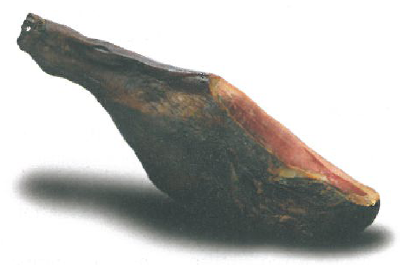Description: Presunto/Paleta do Alentejo PDO is produced, respectively, from the legs and shoulders of ‘Alentejana’ breed pigs, weighting an excess of 5 kg (presunto) or 3,5 kg (paleta). It may be marketed whole, in pieces or sliced, with or without bone.
Production method: The pigs are reared mainly in the open and slaughtered at the age of 12 to 24 months. The ham is processed accordingly to the local traditions, through several phases (cutting, salting, washing and hanging, post-salting and curing), slowly acquiring the appearance, colour, aroma and texture that make it special and unique.
Distinctive features: Presunto/Paleta do Alentejo PDO has a smooth, delicate, slightly salty, lingering, pleasant flavour, occasionally with a slight spiciness.
Production area: Presunto/Paleta do Alentejo PDO production area encompasses the generality of the districts of Beja, Évora and Portalegre and part of the districts of Castelo Branco, Faro, Guarda, Santarém and Setúbal.
History: The origins of Presunto do Alentejo and Paleta do Alentejo PDO are linked to the earliest records of the existence of the Alentejo pig which dates back to several centuries B.C.; proof exists of the pigs and the food they provided during both the Roman and the Arab occupation. Regarding the period of reconquest by the Christians there are written records of the conflict between the farmers and the pig breeders because of the damage the pigs caused to the land, but also of the benefit that the meat and other food products made from these pigs brought to the local community. Between the end of the 19th century and the beginning of the 20th century pig breeding became the most important economy in the Alentejo area and permitted the region and its people to be economically self-sufficient.
The production of Presunto/Paleta do Alentejo PDO is part of a set of ancestral regional practices related to pig farming and the use of their meat. In fact, there are registers of Cato appraising the hams produced in the region. Over the centuries, these practices acquired a paramount economic importance, greatly contributing to the sustainability of the region and of its people.
Product specification (pdf)
Producer group
ACPA - Associação de Criadores de Porco Alentejano
Control and certification body
AGRICERT, Certificação de Produtos Alimentares, Lda
Control plan
Control plan (pdf)
Publication in EU official journal
Regulamento (CE) n.º 944/2008 da Comissão de 26.09.2008 - L 258/54
Regulamento (CE) n.º 510/2006 da Comissão de12.12.2007 - C 300-38
Publication in the Portuguese official journal
Despacho n.º 4597/2005 de 03.03.2005
Aviso n.º 11858/2004 (2.ª série) de 21.12.2004



